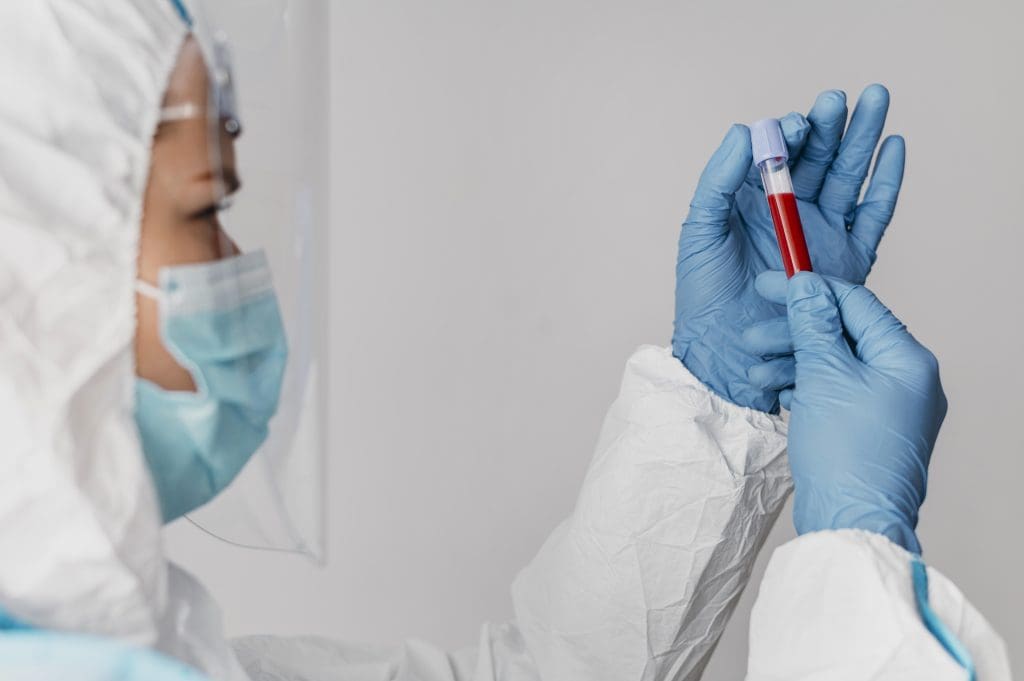Thalassemia affects thousands of people worldwide, causing significant health complications. Understanding whether thalassemia is inherited is key for families and individuals at risk.
We aim to help you understand thalassemia, a genetic disorder that leads to anemia and other serious health issues. By looking into its inheritance pattern, we can grasp the risks and consequences better.

Key Takeaways
- Thalassemia is a genetic disorder affecting hemoglobin production.
- Understanding its inheritance is key for at-risk families.
- The condition leads to significant health complications.
- Knowing the inheritance pattern helps in assessing the risk.
- Thalassemia can cause severe anemia and other health issues.
The Genetic Inheritance of Thalassemia
Grasping the genetic basis of thalassemia is key to understanding its inheritance. Thalassemia is a complex disorder that affects hemoglobin production. Hemoglobin is a protein in red blood cells that carries oxygen.
Thalassemia as a Hereditary Blood Disorder
Thalassemia is a hereditary blood disorder passed down from parents to children through genes. It’s caused by mutations in the genes responsible for hemoglobin production. This leads to anemia and other issues. It’s not contagious and can’t be caught from the environment.
The condition follows an autosomal recessive model. This means a person needs two defective genes (one from each parent) to have thalassemia. Carriers have one normal and one defective gene. They don’t show all symptoms but can pass the mutated gene to their kids.
The Genes Responsible for Thalassemia
Thalassemia is caused by mutations in the HBB or HBA1/2 genes. These genes code for the beta and alpha subunits of hemoglobin. These proteins are vital for hemoglobin’s function. Mutations or deletions in these genes cause thalassemia.
thalassemia genetic mutation inheritance
For example, HBB gene mutations cause beta-thalassemia. HBA1/2 gene mutations cause alpha-thalassemia. Knowing the specific genetic mutation is important for diagnosing thalassemia’s type and severity.
Is Thalassemia Inherited from Parents? Understanding Transmission
Thalassemia is a genetic disorder passed down from parents to children. It follows a specific pattern of inheritance. Knowing this pattern is key for families with thalassemia history.
Thalassemia has an autosomal recessive inheritance pattern. This means the genes causing thalassemia are on non-sex chromosomes. A person needs two defective genes, one from each parent, to have the condition.
Autosomal Recessive Inheritance Pattern
In thalassemia, both parents must carry the gene for a child to risk inheriting it. Carriers have one normal and one defective gene. They usually don’t show full thalassemia symptoms.
When both parents are carriers, their child can inherit three genotypes:
- A child can get two normal genes, not having thalassemia and not being a carrier.
- A child can get one normal and one defective gene, becoming a carrier like their parents.
- A child can get two defective genes, one from each parent, and have thalassemia.
Probability of Inheritance from Carrier Parents
The chance of a child getting thalassemia when both parents are carriers is:
- 25% chance of having thalassemia (two defective genes)
- 50% chance of being a carrier (one defective and one normal gene)
- 25% chance of not having thalassemia and not being a carrier (two normal genes)
Knowing these chances is vital for genetic counseling and family planning for carrier parents.
thalassemia inheritance pattern
Understanding thalassemia’s autosomal recessive pattern helps families grasp their risks. This knowledge aids in making informed health and reproductive choices.
Who Carries the Thalassemia Gene? Carrier Status Explained
Carrying the thalassemia gene doesn’t mean you’ll get sick. But, you can pass it to your kids. Thalassemia is a genetic disorder that affects how red blood cells carry oxygen.
Identifying Thalassemia Carriers
People with thalassemia traits or minors don’t show all symptoms. Yet, they can pass the gene to their children. It’s important to find carriers for family planning and genetic counseling.
To find thalassemia carriers, we use:
- Blood Tests: Tests like Complete Blood Count (CBC) can show if someone is a carrier.
- Genetic Testing: DNA tests can spot the genetic mutations causing thalassemia.
- Family History: A family history of thalassemia can lead to carrier testing.
Health Implications for Silent Carriers
Being a thalassemia carrier usually doesn’t affect your health. But, you should know you might pass it to your kids.
Carriers should remember:
- They often don’t show symptoms or have mild ones.
- If both parents are carriers, there’s a 25% chance each child will have thalassemia major.
- Genetic counseling helps understand risks and plan families.
Knowing if you’re a carrier is key to managing thalassemia. It helps families make smart health choices.
How Alpha Thalassemia is Passed Down in Families
Alpha thalassemia is a genetic disorder that affects how the body makes hemoglobin. It is passed down through families based on the alpha-globin genes. We will look at how these genes are inherited and the different symptoms that can occur.
Alpha Globin Gene Deletions
Alpha thalassemia happens when there are deletions or mutations in the alpha-globin genes. People usually have four of these genes, two from each parent. The severity of the disorder depends on how many genes are affected.
When genes are deleted or mutated, it leads to less alpha-globin chains. These chains are key for hemoglobin. The more genes affected, the worse the condition.
alpha thalassemia inheritance
The Four Clinical Presentations of Alpha Thalassemia
The symptoms of alpha thalassemia change based on how many genes are affected. There are four main types:
| Number of Affected Genes | Clinical Presentation | Description |
| 1 | Silent Carrier | People usually don’t show symptoms but can pass the gene to their kids. |
| 2 | Alpha Thalassemia Trait | Some may have mild anemia but usually live normal lives. |
| 3 | Hemoglobin H Disease | This type has moderate to severe anemia and might need blood transfusions. |
| 4 | Hydrops Fetalis | A very severe condition where the fetus needs blood transfusions to survive. |
Knowing about alpha thalassemia’s genetics and symptoms is key for families with a history of it. Genetic counseling and testing help with planning and managing the condition.
How Beta Thalassemia is Passed Down in Families
To understand how beta thalassemia is passed down, we need to look at its genetic roots. It’s caused by changes in the HBB gene. This gene is key for making the beta-globin part of hemoglobin, a vital protein in red blood cells.
Beta Globin Gene Mutations
The HBB gene makes the beta-globin chains of hemoglobin. Changes in this gene can lead to less or no beta-globin chains. This results in beta thalassemia. There are over 200 known mutations that can cause this disease, and the type and severity of the mutation decide the disease’s form.
These mutations are passed down in an autosomal recessive pattern. This means a child needs to get a mutated HBB gene from both parents to have beta thalassemia major. If a child gets only one mutated gene, they will be a carrier, usually having beta thalassemia minor.
Major, Intermedia, and Minor Forms
Beta thalassemia comes in different forms based on the mutation’s severity and its effect on beta-globin production. The major forms include:
- Beta Thalassemia Major: This is the most severe form, where individuals have significant anemia and need regular blood transfusions.
- Beta Thalassemia Intermedia: This form is less severe than major but more severe than minor. People may have some anemia but usually don’t need regular transfusions.
- Beta Thalassemia Minor: Carriers have mild anemia or no symptoms at all. They are generally healthy but can pass the mutated gene to their offspring.
Knowing these different forms is key for managing the condition and planning families. Genetic counseling helps people understand their reproductive health better.
Inheritance of Thalassemia Minor: What Carriers Should Know
Carriers of thalassemia minor usually live healthy lives. But, they need to know about the genetic side. Thalassemia minor, or beta-thalassemia trait, is a mild form that can be passed on. It’s key for planning families and taking care of one’s health.
Mild Symptoms and Management
People with thalassemia minor often have mild anemia or no symptoms. They might feel tired, have pale skin, or slight jaundice. To manage, they should see doctors regularly and eat well, focusing on iron and vitamins.
Nutritional Considerations: Carriers don’t usually need treatment but should eat enough iron. Foods high in vitamin C help absorb iron better. So, eating citrus fruits, bell peppers, or tomatoes with iron-rich foods is good.
thalassemia minor inheritance
Reproductive Considerations for Carriers
If both partners carry thalassemia minor, there’s a 25% chance their child will have thalassemia major, a more serious form. Genetic counseling helps understand risks and options.
| Parental Carrier Status | Risk of Thalassemia Major in Offspring | Risk of Being a Carrier |
| One parent is a carrier | 0% | 50% chance of passing the trait |
| Both parents are carriers | 25% | 50% chance of being a carrier |
Knowing these risks is important for planning families. Carriers should get genetic tests and counseling. This helps them make smart choices about having children.
Can a Baby Inherit Thalassemia Major? Severe Form Inheritance
When both parents carry the thalassemia gene, there’s a big chance their baby could get thalassemia major. It’s important for expecting parents to know about this risk. They should also learn about prenatal detection and management options.
When Both Parents are Carriers
If both parents carry the thalassemia gene, there’s a 25% chance with each pregnancy that the child will have thalassemia major. This happens when a child gets two mutated genes, one from each parent. It leads to severe anemia and other problems.
The way thalassemia major is passed down is called autosomal recessive. This means both parents must carry the mutated gene. The child must get both genes to have the condition.
Prenatal Detection and Management
It’s possible to find out if a baby has thalassemia major before birth. Tests like:
- Chorionic Villus Sampling (CVS): This test takes a small sample from the placenta between 10 and 12 weeks.
- Amniocentesis: This test takes a sample of amniotic fluid around 15-20 weeks to check for genetic issues.
Early detection helps parents make choices about the pregnancy. It also prepares them for caring for a child with thalassemia major. Managing thalassemia major usually means regular blood transfusions and iron chelation therapy.
It’s key for families to know about the risks and management of thalassemia major. Genetic counseling offers support and guidance for families dealing with thalassemia inheritance.
Thalassemia Genetic Mutation Inheritance: The Science Explained
Thalassemia is a genetic disorder that affects how red blood cells make hemoglobin. This is a key protein. It’s caused by changes in the genes that code for hemoglobin. Knowing about these genetic changes helps us understand how thalassemia is passed down.
Common Mutations by Population
Thalassemia mutations vary by population. For example, some mutations are more common in people from the Mediterranean. Others are found more often in Southeast Asia.
The variety of thalassemia mutations shows where and when the disease spread. In the Mediterranean, beta-thalassemia is common due to beta-globin gene mutations. In Southeast Asia, alpha-thalassemia is more common because of alpha-globin gene mutations or deletions.
How Mutations Disrupt Hemoglobin Synthesis
Thalassemia mutations mess up hemoglobin production. This leads to less or no globin chains. This problem causes anemia and other issues related to thalassemia.
These mutations can either lower globin chain production or create abnormal chains. For instance, in beta-thalassemia major, a mutation greatly reduces beta-globin chains. This results in severe anemia.
“The severity of thalassemia is directly related to the type and extent of the genetic mutation,” as noted by experts in the field.
Thalassemia Family History: Assessing Your Risk
Looking into your family history can tell you a lot about your risk for thalassemia. Knowing your relatives’ health can help you figure out your own risk. This knowledge can guide your health decisions.
Creating a Family Pedigree
Making a family pedigree means collecting health info on your family. This includes your immediate and extended family’s health, focusing on thalassemia or other genetic issues. It helps spot patterns that might show a higher risk of thalassemia.
To make a detailed family pedigree, you should:
- Get health history from parents, siblings, and grandparents.
- Include any thalassemia diagnosis or carrier statuses.
- Also, note any other genetic disorders or health issues.
This way, you can spot genetic risks and talk about them with your doctor.
Identifying Patterns of Inheritance
Thalassemia follows an autosomal recessive pattern. This means you need two bad genes (one from each parent) to have the condition. Carriers, with one good and one bad gene, usually don’t show severe symptoms but can pass the bad gene to their kids.
| Parental Carrier Status | Risk to Offspring |
| Both parents are carriers | 25% chance of having a child with thalassemia major |
| One parent is a carrier, the other is not | 50% chance of having a child who is a carrier |
| Neither parent is a carrier | Low risk of having a child with thalassemia |
A leading geneticist says, “Knowing how thalassemia is inherited is key for families with a history of it. It helps them make smart choices about having kids and prepares them for health issues.”
“Genetic counseling can provide families with the necessary tools to navigate the complexities of thalassemia inheritance.”
By understanding your family’s health history and thalassemia inheritance, you can better understand your risk. This knowledge helps you take steps to manage your health.
Co-inheritance of Thalassemia with Other Hemoglobin Disorders
When thalassemia is inherited with other hemoglobin disorders, the health issues can be complex. This mix can lead to various health problems. It’s important to know how these genetic conditions interact.
Thalassemia and Sickle Cell Trait
Thalassemia and sickle cell trait together are a big worry in areas where both are common. People with both may face symptoms like anemia, jaundice, and a higher risk of infections.
Some important points to remember include:
- They might face severe anemia from both conditions.
- They could have more pain episodes and other sickle cell disease complications.
- They need close monitoring and careful management to reduce health risks.
Hemoglobin E/Thalassemia Combinations
Hemoglobin E/thalassemia is another serious combination that affects health. It can be more severe than thalassemia minor but less severe than thalassemia major.
The symptoms of Hemoglobin E/thalassemia can vary. But common signs include:
- Anemia that may need regular blood transfusions.
- Splenomegaly and other issues from chronic hemolysis.
- They need ongoing medical care for their symptoms and complications.
It’s key to understand the effects of thalassemia co-inherited with other hemoglobin disorders. This knowledge helps in providing the right care and support to those affected.
Thalassemia Genetic Testing: Options and Considerations
Thalassemia genetic testing gives us insight into the risk of passing this condition to future generations. As genetics advances, knowing the different testing options is key for those affected by thalassemia.
Carrier Screening Methods
Carrier screening for thalassemia is vital for identifying those who carry the thalassemia gene. It’s important for people from areas where thalassemia is common, like the Mediterranean, Southeast Asia, and the Middle East. There are several methods for carrier screening, including:
- Blood tests to measure hemoglobin levels and detect abnormalities
- Genetic testing to identify mutations in the HBB or HBA1/2 genes
Spotting carriers early helps with family planning and lowers the chance of a child having severe thalassemia.
Prenatal and Preimplantation Testing
Couples who are both carriers of thalassemia can use prenatal testing to learn about their unborn child’s risk. Prenatal testing includes:
- Chorionic villus sampling (CVS)
- Amniocentesis
These tests can diagnose thalassemia major or other severe forms in the fetus. Preimplantation genetic diagnosis (PGD) is another choice for at-risk couples undergoing IVF. It lets them pick embryos not affected by thalassemia.
Newborn Screening Programs
Newborn screening for thalassemia is part of many national programs. Early detection through newborn screening can greatly improve outcomes for children with thalassemia major. It allows for early intervention and management.
The following table summarizes the different genetic testing options for thalassemia:
| Testing Method | Purpose | Timing |
| Carrier Screening | Identify carriers of thalassemia gene | Pre-conception or early pregnancy |
| Prenatal Testing (CVS, Amniocentesis) | Diagnose thalassemia in the fetus | First or second trimester |
| Preimplantation Genetic Diagnosis (PGD) | Select unaffected embryos during IVF | During IVF cycle |
| Newborn Screening | Detect thalassemia in newborns | At birth |
Understanding genetic testing options helps families make informed decisions about their reproductive health and thalassemia management. We suggest talking to a healthcare provider or genetic counselor to find the best testing strategy for your situation.
Family Planning with Thalassemia Hereditary Traits
Planning a family when both partners carry thalassemia traits is complex. It’s about understanding genetic risks and looking at different ways to have children. If both parents carry the trait, there’s a high chance their kids could get thalassemia major. Making smart choices is key.
Genetic Counseling for At-Risk Couples
Genetic counseling is a first step for couples at risk. It helps them understand their genetic situation and the chances of passing thalassemia to their kids. Genetic counselors guide them on the risks and what each choice means.
During counseling, couples learn about their family’s health history and thalassemia’s genetics. They find out the odds of having a child with thalassemia major. This info is essential for making good choices about having kids.
“Genetic counseling empowers couples to make informed decisions about their reproductive options, reducing the risk of having a child with thalassemia major.”
” A Genetic Counselor
Reproductive Options and Technologies
Thanks to new medical tech, at-risk couples have many options. These include:
- Prenatal Testing: CVS and amniocentesis can spot thalassemia in the fetus.
- Preimplantation Genetic Diagnosis (PGD): With IVF, PGD picks embryos without thalassemia.
- Donor Gametes: Using donor eggs or sperm means no thalassemia risk.
| Reproductive Option | Description | Benefits |
| Prenatal Testing | Diagnosis thalassemia in the fetus through CVS or amniocentesis. | Allows for informed decision-making about the pregnancy. |
| Preimplantation Genetic Diagnosis (PGD) | Used with IVF to select unaffected embryos. | Reduces the risk of having a child with thalassemia major. |
| Donor Gametes | Uses eggs or sperm from a non-carrier donor. | Eliminates the risk of passing on thalassemia. |
Ethical Considerations
Choosing a reproductive path is not just about health. It’s also about ethics. Couples must think about the risks, the suffering a child might face, and their views on new reproductive tech.
Ethical support is key. It helps couples deal with tough choices that affect their feelings and well-being. Healthcare teams, counselors, and support groups offer the help needed to make the right choice for them.
Global Distribution of Thalassemia Genetic Factors
Thalassemia, a blood disorder, is found all over the world. But it’s more common in some places. This is because of where people live and their ethnicity.
Thalassemia is often linked to the Mediterranean. But it’s also common in Southeast Asia, the Middle East, and Africa. This is because people with thalassemia trait can survive better in areas with malaria.
Mediterranean Basin Prevalence
The Mediterranean has a lot of thalassemia. Countries like Greece, Italy, and Cyprus have many people with the thalassemia trait. This has led to screening programs and health efforts to lower thalassemia major cases.
Southeast Asian Patterns
In Southeast Asia, like Thailand, Indonesia, and Malaysia, thalassemia is also common. The genetic causes of thalassemia here are different from the Mediterranean. This shows the genetic variety of the disorder.
Middle Eastern and African Distribution
The Middle East and parts of Africa also have a lot of thalassemia. Managing it here is hard because of limited healthcare and screening. It’s important to improve diagnosis and treatment in these areas.
Knowing where thalassemia is common helps healthcare and policy makers. It guides screening, health efforts, and research. By studying thalassemia, we learn more about genetics and how to help those affected all over the world.
Living with Inherited Thalassemia: Psychological and Social Aspects
Managing thalassemia is more than just medical care. It needs a full approach that looks at the mind and social life too. Living with thalassemia can deeply affect emotions and social life, not just for the person but their family too.
Coping with a Genetic Diagnosis
Getting a thalassemia diagnosis can be tough. It’s a genetic issue that impacts not just the person but their family too. Coping with this diagnosis means learning about the condition, its care, and the emotional help out there.
- Understanding the condition and its implications
- Seeking emotional support from family, friends, or support groups
- Engaging in counseling or therapy to manage stress and anxiety
Support Resources for Families
Families with thalassemia can find many support options. Support groups, online or in-person, are great for sharing stories and tips. Also, educational materials help families grasp the condition and manage it better.
- Access to thalassemia support groups and networks
- Educational materials and workshops
- Professional counseling services
Advocacy and Community
Advocacy is key in spreading thalassemia awareness, pushing for research, and backing families. Being part of a community that fights for thalassemia awareness gives people and families a sense of belonging and support.
We know managing thalassemia well means tackling its mental and social sides too. By giving support, resources, and advocacy, we can make life better for those with this condition and their families.
Conclusion
Thalassemia inheritance is a complex process. It involves the genetic transmission of this hereditary blood disorder. Understanding this is key for those affected and their families.
Genetic testing has greatly improved diagnosis and management of thalassemia. It helps identify carriers and understand transmission risks. This knowledge aids in family planning and prenatal care decisions.
Managing thalassemia requires a detailed approach. This includes regular blood transfusions, iron chelation therapy, and other treatments. Ongoing research and medical advancements improve life quality for those with thalassemia.
It’s vital to keep raising awareness about thalassemia inheritance and genetic screening. This effort offers hope and support to those affected. It also improves their well-being and future outlook.
FAQ
Is thalassemia a genetic disorder?
Yes, thalassemia is a genetic disorder. It’s caused by mutations in genes that make hemoglobin. These mutations affect the production of hemoglobin’s alpha or beta chains, leading to different forms of the disorder.
How is thalassemia inherited?
Thalassemia is inherited in an autosomal recessive pattern. This means a person needs two mutated genes (one from each parent) to have the condition. Carriers, with one normal and one mutated gene, usually don’t show symptoms but can pass the mutated gene to their kids.
What does it mean to be a thalassemia carrier?
Being a thalassemia carrier means having one normal and one mutated gene for hemoglobin production. Carriers are usually healthy or have mild symptoms. They can pass the mutated gene to their children. If both parents are carriers, there’s a chance their child could get two mutated genes and have thalassemia major.
How is alpha thalassemia inherited?
Alpha thalassemia is caused by mutations or deletions in genes for alpha-globin. The inheritance pattern involves getting a mutated gene from each parent. The severity of the condition depends on how many genes are affected.
What are the different forms of beta thalassemia?
Beta thalassemia has different forms, like beta thalassemia major, intermedia, and minor. These depend on the severity of the mutations in the beta-globin genes. Beta thalassemia major is the most severe, needing regular blood transfusions. Beta thalassemia minor usually causes mild anemia.
Can thalassemia be passed down from parents to children?
Yes, thalassemia can be passed down from parents to children. If both parents are carriers, there’s a chance their child could get two mutated genes and have thalassemia major.
What is the significance of family history in assessing thalassemia risk?
Family history is key in assessing thalassemia risk. It helps identify carriers of the mutated gene. Knowing the inheritance pattern in a family helps individuals understand their risk and make informed reproductive choices.
What genetic testing options are available for thalassemia?
Genetic testing for thalassemia includes carrier screening, prenatal testing, and preimplantation genetic diagnosis. These tests can find mutations in genes responsible for hemoglobin production. They help individuals understand their carrier status and the risk to their offspring.
How does co-inheritance of thalassemia with other hemoglobin disorders affect the condition?
Co-inheritance of thalassemia with other hemoglobin disorders, like sickle cell trait or hemoglobin E, can lead to compound conditions. These can have varying degrees of severity. Understanding these interactions is key for managing health implications for affected individuals.
What are the global patterns of thalassemia distribution?
Thalassemia is more common in certain regions, like the Mediterranean, Southeast Asia, the Middle East, and parts of Africa. Knowing these global patterns helps identify populations at higher risk. It also aids in implementing screening and management strategies.
What family planning options are available for couples at risk of having a child with thalassemia?
Couples at risk can explore family planning options like genetic counseling, prenatal diagnosis, and preimplantation genetic diagnosis. These options help couples make informed reproductive choices and manage the risk of having a child with thalassemia.
How can families cope with a diagnosis of thalassemia?
Families can cope with a thalassemia diagnosis by seeking support from healthcare providers, joining support groups, and accessing advocacy resources. Understanding the condition, its management, and available support helps families navigate the challenges of thalassemia.






